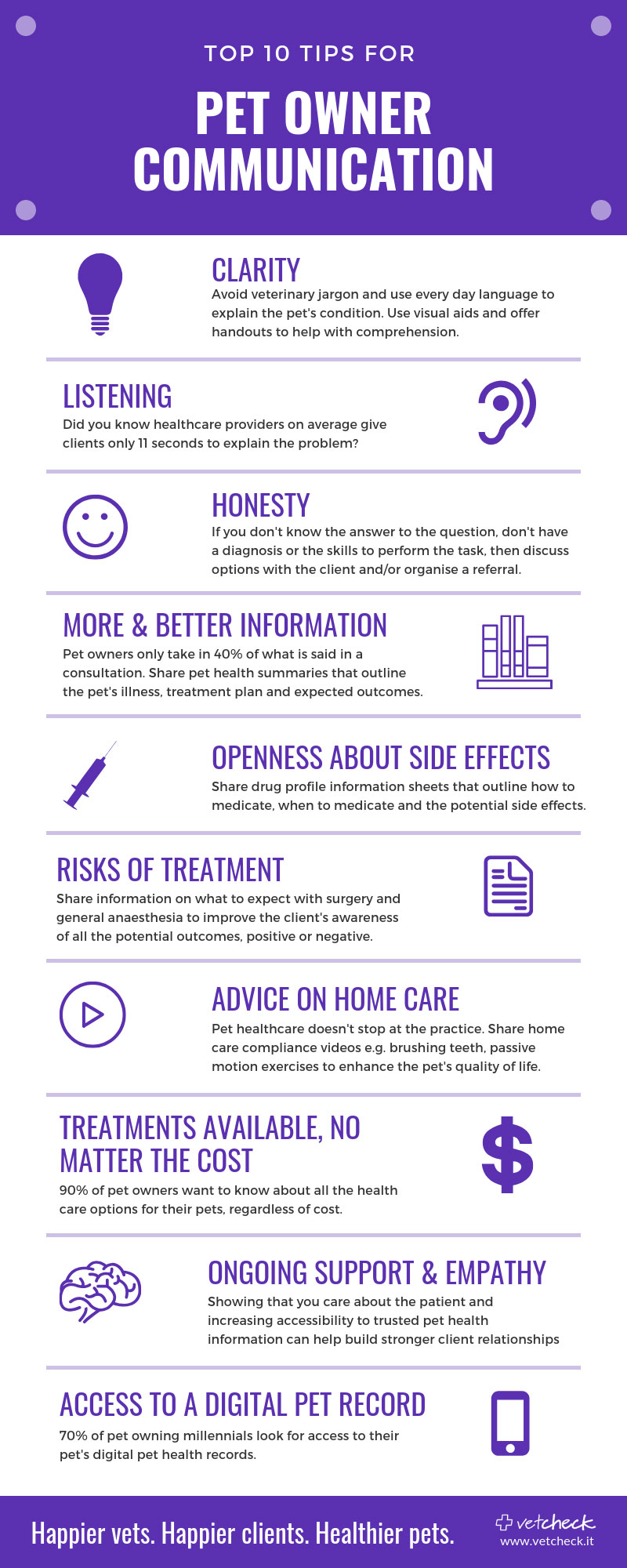
Why good communication is key to good veterinary practice
Good communication underpins every aspect of good veterinary practice. It can increase after-care compliance, enhance pet owner satisfaction and most importantly better pet health outcomes. Yet investigations into unprofessional conduct in the veterinary profession are often the result of communication breakdown. Despite the best veterinary care, clinical cases may not always have good outcomes. Bad outcomes combined with poor communication can lead to complaints.
Complaints can be emotionally and physically stressful to veterinary professionals causing one to question their process of care. Risks surround veterinary professionals every day but recognizing that the greatest risk is poor communication can help veterinarians to implement processes to protect themselves and their practice.
Honest and open communication is key. In human medicine, the more likeable the doctor, the more likely you are to believe you are receiving high-quality care.1 It is estimated that over 60 percent of pet owners consider their pets as family members. These highly bonded customers have significantly greater expectations when it comes to the care they receive.2 Showing genuine care for a pet will create customers that are more forgiving should an unexpected event occur. Empathy, concern and reassurance along with easy to understand instructions has shown to result in higher levels of client satisfaction and adherence.3

Steps to Effective Communication
- Listen carefully
- Show empathy and concern
- Offer clear answers and instructions
- Seek assistance or referral when appropriate
- Address customer concerns or complaints
- Set realistic expectations
- Inform all relevant family members, as primary carers are not always present
- Offer verbal and written digital communications in simple language
- Maintain current professional knowledge
- Training of staff to develop a team of well-educated communicators
- Written communication protocols
- Document all communications
Informed consent is essential. Pet owners should have a full understanding of the risks and complications; e.g., the spinal surgery may lead to paralysis or the general anesthesia on rare occasions may result in death. This should be given as a verbal and written explanation. Written client communications should be easy to read, use minimal veterinary terms, be no longer than a page, cover key home care instructions (feeding, restrictions, medications etc) and detail what to look out for or what to expect. Digital communications are easier and more convenient for customers to refer back to or share with all family members.
A human medicine study demonstrated that only 50 percent of patients could recall healthcare instructions and only 70 percent of those who could recall them, followed them. In veterinary medicine, adherence is estimated at 48 percent for heartworm prevention, 35 percent for dental prophylaxis and 19 percent for therapeutic nutrition.4 Appreciating that a visit to the vet is generally a stressful experience: pet owners have to restrain their pet, complete forms at check-in and comfort the pet during a procedure;5 communication should be empathetic and consistent at each touch point and tailored to the pet owner’s needs. It is estimated that over 80 percent of customers do not undergo treatment recommendations due to confusion rather than due to costs.
With the rapid rise in smartphones, pet owners are highly connected. Offering digital treatment plans specific to the pet owner is not only convenient, but they add value and make it easier for customers to refer back to. Customers who receive written information generally have a higher rate of compliance.6 Improved compliance not only improves pet health outcomes and client satisfaction but also grows business and veterinarian satisfaction. However, compliance programs require commitment from all staff and support from practice leadership.
Best Practices for Improving Compliance
- Verbal communication at each touch point (on phone, in consultation)
- Personalized treatment plans
- Client handouts
- Forward booking appointments
- Appointment confirmation
- Appointment reminder
- Follow up phone calls
Effective communications can improve health outcomes, compliance rates, patient satisfaction and more importantly reduce malpractice risk.7
At the end of the day, the customer will differentiate a veterinary practice from the one down the road by the level of customer service they receive. Offering a personalized and empathetic experience will ensure that your customers remain loyal.
References
Clark PA. “Medical practices’ sensitivity to patients’ needs: Opportunities and practices for improvement,” Journal of Ambulatory Care Management 2003;26:110-123.
Determining the characteristics of effective veterinary-client communication using the client’s perspective, the human-animal bond, and communication accommodation theory, Michael Meehan (2011). Determining the characteristics of effective veterinary-client communication using the client’s perspective, the human-animal bond, and communication accommodation theory PhD Thesis, School of Veterinary Science, The University of Queensland.
Determining the characteristics of effective veterinary-client communication using the client’s perspective, the human-animal bond, and communication accommodation theory, Michael Meehan (2011). Determining the characteristics of effective veterinary-client communication using the client’s perspective, the human-animal bond, and communication accommodation theory PhD Thesis, School of Veterinary Science, The University of Queensland.
“The path to high-quality care: Practical tips for improving compliance,” American Animal Hospital Association, 2003.
106 out of 135 patients show fear on the examination table – that’s nearly 80%
Doring D, Roscher A, Chelpi F et al. Fear-related behaviour of dogs in veterinary practice. Vet J 2009;182:38-43
2009 AAHA Compliance Follow-Up Study
Bayer Animal Health Communication Project, Institute for Healthcare Communication; Baile WF, Aaron J. “Patient-physician communication in oncology: Past, present, and future,” Current Opinion in Oncology 2005;17:331-335.